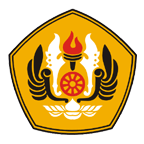Application of Common Greenbottle Fly (Lucilia sericata Meigen, 1826) Larvae Extract for Incision Wound Treatments in Rats
Abstrak
Common green-bottle fly (Lucilia sericata) larvae have been used in maggot debridement therapy to promote wound healing since the 19th century following the emergence of an antibiotic-resistant strain of bacteria. Whole body extracts and hemolymph of L. sericatalarvae shown antibacterial properties. This research aims to examine the ethanol extract from whole body of L. sericatalarvae to accelerate the wound healing on the skin of male Wistar rats (Rattus norvegicus). The method was a completely randomized design with six treatments and four replications each. The incision wound created at the dorsolateral region of shaven skin at ±1.5 cm using sterile scissors. The extract at concentration 5, 10 and 20% in olive oil were applied topically to wounded rats, as well as Betadine® for the reference group. For positive control only olive oil applied to wounded rats, as for negative control was non-treated wounded rats. The treatment was done twice a day for 14 days. At day 15th, the wounded site harvested, fixed in 10% NBF, embedded in paraffin, and sectioned at 5-7 µm, then stained with hematoxylin-eosin or trichrome Heidenhain’s Azan for histological examination. The results showed that topical application of the L. sericata larvae extract at concentration 10% was significantly recover the wounded skin by enhanced re-epithelialization, narrowed granulation tissue, as well as increased capillary number and collagen density than other treatments (p<0.05). Overall, our data support the
L. sericatalarva extract as an agent to accelerate the wound healing process on skin.
Key words: ethanol extract, green-bottle fly, incision wound, whole body larva, wound healing.
Teks Lengkap:
PDF (English)Referensi
Singer AJ, Clark RAF. Cutaneous Wound Healing. N Engl J Med. 1999;341(10):738-746. doi:10.1056/NEJM199909023411006.
Velnar T, Bailey T, Smrkolj V. The wound healing process: an overview of the cellular and molecular mechanisms. J Int Med Res. 2015;37(5):1528-1542. doi:10.1177/147323000903700531.
Flanagan M, Ed C. The Physiology of Wound Healing. J Wound Care. 2000;9(6):299-300.
Nigam Y, Dudley E, Bexfield A, Bond AE, Evans J, James J. The Physiology of Wound Healing by the Medicinal Maggot, Lucilia sericata. In: In Insect Physiology Advances.; 2010:39-81. doi:10.1016/ B978-0-12-381387-9.00002-6.
Bayat A. Skin scarring. Bmj. 2003;326(7380):88-92. doi:10.1136/bmj.326.7380.88.
Parnes A, Lagan KM. Larval therapy in wound management: A review. Int J Clin Pract. 2007;61(3):488-493. doi:10.1111/j.1742-1241.2006.01238.x.
Mumcuoglu KY, D P, Ingber A, et al. Pharmacology and therapeutics Maggot therapy for the treatment of intractable wounds. Int J Dermatol. 1999;38:623-627. doi:10.1046/ j.1365-4362.1999.00770.x.
Čeřovský V, Žďárek J, Fučík V, Monincová L, Voburka Z, Bém R. Lucifensin, the long-sought antimicrobial factor of medicinal maggots of the blowfly Lucilia sericata. Cell Mol Life Sci. 2010;67(3):455-466. doi:10.1007/s00018-009-0194-0.
Petherick ES, O’Meara S, Spilsbury K, Iglesias CP, Nelson EA, Torgerson DJ. Patient acceptability of larval therapy for leg ulcer treatment: A randomised survey to inform the sample size calculation of a randomised trial. BMC Med Res Methodol. 2006;6:4-7. doi:10.1186/1471-2288-6-43.
Spilsbury K, Cullum N, Dumville J, O’Meara S, Petherick E, Thompson C. Exploring patient perceptions of larval therapy as a potential treatment for venous leg ulceration. Heal Expect. 2008;11(2):148-159. doi:10.1111/j.1369-625.2008.00491.x.
Huberman L, Gollop N, Mumcuoglu KY, Block C, Galun R. Antibacterial properties of whole body extracts and haemolymph of Lucilia sericata maggots. J Wound Care. 2007;16(3):123-127. doi:10.12968/jowc.2007.16.3.27011.
Daeschlein G, Mumcuoglu KY, Assadian O, Hoffmeister B, Kramer A. In vitro antibacterial activity of Lucilia sericata maggot secretions. Skin Pharmacol Physiol. 2007;20(2):112-115. doi:10.1159/000097983.
Valachová I, Bohová J, Pálošová Z, Takáč P, Kozánek M, Majtán J. Expression of lucifensin in Lucilia sericata medicinal maggots in infected environments. Cell Tissue Res. 2013;353(1):165-171. doi:10.1007/s00441-013-1626-6.
Vidinský B, Gál P, Toporcer T, et al. Histological study of the first seven days of skin wound healing in rats. Acta Vet Brno. 2006;75(2):197-202. doi:10.2754/avb200675020197.
Chen J, Kasper M, Heck T, et al. Tissue factor as a link between wounding and tissue repair. Diabetes. 2005;54(7):2143-2154. doi:10.2337/diabetes.54.7.2143.
Prete PE. Growth effects of Phaenicia sericata larval extracts on fibroblasts: Mechanism for wound healing by maggot therapy. Life Sci. 1997;60(8):505-510. doi:10.1016/S0024-3205(96)00688-1.
Pálošová Z, Takáč P, Šrobárová A. Antifungal activity of blow-fly (Lucilia sericata) saliva at the Fusarium sp. control. Cereal Res Commun. 2008;36:715-717.
Telford G, Brown AP, Seabra RAM, et al. Degradation of eschar from venous leg ulcers using a recombinant chymotrypsin from Lucilia sericata. Br J Dermatol. 2010;163(3):523-531. doi:10.1111/j.1365-2133.2010.09854.x.
Zhang Z, Wang S, Diao Y, Zhang J, Lv D. Fatty acid extracts from Lucilia sericata larvae promote murine cutaneous wound healing by angiogenic activity. Lipids Health Dis. 2010;9:1-9. doi:10.1186/1476-511X-9-24.
Linger RJ, Belikoff EJ, Yan Y, et al. Towards next generation maggot debridement therapy: Transgenic Lucilia sericata larvae that produce and secrete a human growth factor. BMC Biotechnol. 2016;16(1):1-12. doi:10.1186/s12896-016-0263-z.
DOI: https://doi.org/10.24198/ijpst.v1i1.19144
Refbacks
- Saat ini tidak ada refbacks.
| Switch to English Back to Top |
| View My Stats Penerbit Universitas Padjadjaran
Jurnal ini terindeks di :Creative Commons Attribution :
Based on a work at http://jurnal.unpad.ac.id/ijpst/ |
 Indonesian Journal of Pharmaceutical Science and Technology
Indonesian Journal of Pharmaceutical Science and Technology




